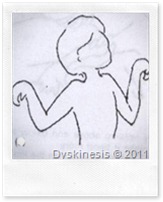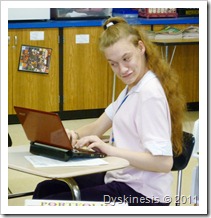Blog Archives
Athetosis
This disease was discovered in first place by a guy named Hammond in 1871, it is mainly about people who don’t like to have the toes and fingers in any place or position in which they might be planed, as well as their continuous motion. 
This is because these people who have Athetosis also have a cerebral affection, they present a combination of symptoms which are characterized by a –more or less- constant mobility of the extremities and they also have the inability to retain them in any fixed position. This could be one of the most uncomfortable diseases I’ve ever known about.
The movements tend to be involuntary and turn out to be morbid or even grotesque, they are somehow regular and rigid, they don’t seem to be jerky or spasmodic. Now the movement of the digits are a bit different from those attending any other disease, they are impossible to imitate even by the most skilful malingerer and if you could see them, you wouldn’t forget them easily.
 In an athetoid hand, the interossei and lumbricales, wich are used to flex the metacarpo-phalangeal and to extend the phalangeal joints, are affected, but there are these rare cases in which the long extensors and flexors are affected. This means that the hand will be in the interosseal position, in other words, the hand will seem contracted. The movements of the toes depend to those of the fingers in point of action.
In an athetoid hand, the interossei and lumbricales, wich are used to flex the metacarpo-phalangeal and to extend the phalangeal joints, are affected, but there are these rare cases in which the long extensors and flexors are affected. This means that the hand will be in the interosseal position, in other words, the hand will seem contracted. The movements of the toes depend to those of the fingers in point of action.
The disease could be confined to one side –hemiathetosis- and is a sequel of hemiplegia1 . The differential diagnosis is easily made, because the only affections which we could possibly confounded with are chorea2 and paralysis agitans3.
The following is a case regarding a quadruple athetosis, associated with epilepsy and insanity. The patient was an afroamerican woman, 26 years old and was mother of 1 child, in 1886. She had had epilepsy of the grand mal type4 for many years. She continued to have epilepsy and ultimately it lead to a degenerated state of almost absolute imbecility.
 The experts tend to say that some degree of mental deficiency is usually related to athetosis, even when uncomplicated by any other degenerating neurosis. For this woman was impossible to track the beginning of her symptoms, she was admitted into the hospital with affections to her extremities, both lower and upper. She never had any attack of apoplexy nor paralysis and she seemed perfectly normal, but her pedal extremities involuntarily assumed various distorted positions and were constantly moving. The feet were moved upon the ankles in a stiff and awkward manner and the muscles became hard and rigid. She died in January 1895, after an obstinate attack of status epilepticus.
The experts tend to say that some degree of mental deficiency is usually related to athetosis, even when uncomplicated by any other degenerating neurosis. For this woman was impossible to track the beginning of her symptoms, she was admitted into the hospital with affections to her extremities, both lower and upper. She never had any attack of apoplexy nor paralysis and she seemed perfectly normal, but her pedal extremities involuntarily assumed various distorted positions and were constantly moving. The feet were moved upon the ankles in a stiff and awkward manner and the muscles became hard and rigid. She died in January 1895, after an obstinate attack of status epilepticus.
To this people, the act of walking became considerably difficult because of contractures and also because the feet were not exactly under the control of the will. Their health is fairly good, sometimes they are irritable and violent so their athetoid movements are intensified.
The treatment for this disease depends on the goal, and the kind of patient, cause some may be too young or small, some of them could be treated by oral medications – like Primidone – or intramuscular injections, but for the adults the surgical treatment could be recommended. Occasionally, it is not clear which treatment would be the most appropriate.
1- Hemiplegia is total paralysis of the arm, leg, and trunk on the same side of the body.
2– Chorea is an abnormal involuntary movement disorder, one of a group of neurological disorders called dyskinesias.
3– Paralysis Agitans also called Parkinson’s disease is a disorder of the brain that leads to shaking and difficulty with walking, movement, and coordination.
4– Grand mal seizure features a loss of consciousness and violent muscle contractions and affects the entire brain.
